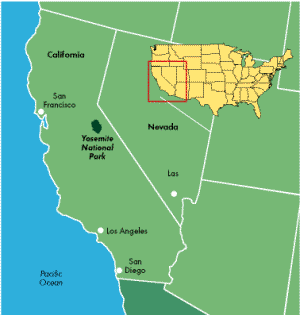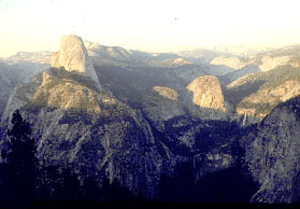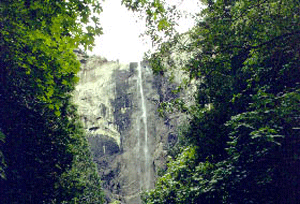by April Rowan
May 2000
NOTICE: THIS WORK MAY BE PROTECTED BY COPYRIGHT
YOU ARE REQUIRED TO READ THE COPYRIGHT NOTICE AT THIS LINK BEFORE YOU READ THE FOLLOWING WORK, THAT IS AVAILABLE SOLELY FOR PRIVATE STUDY, SCHOLARSHIP OR RESEARCH PURSUANT TO 17 U.S.C. SECTION 107 AND 108. IN THE EVENT THAT THE LIBRARY DETERMINES THAT UNLAWFUL COPYING OF THIS WORK HAS OCCURRED, THE LIBRARY HAS THE RIGHT TO BLOCK THE I.P. ADDRESS AT WHICH THE UNLAWFUL COPYING APPEARED TO HAVE OCCURRED. THANK YOU FOR RESPECTING THE RIGHTS OF COPYRIGHT OWNERS.
Yosemite National Park is home to a host of natural wonders: thundering waterfalls, massive granite domes, and towering sequoias. Its unusual beauty was prized by the native Americans who once lived in the area, as well as by the European settlers who supplanted them. Today, Yosemite is one of the United States' most popular national parks, attracting about 2.5 million visitors each year. Unfortunately, the activities of these visitors, combined with the facilities designed to attract their business, are threatening to rob Yosemite of its wild character.
Describing the Resource
Physical Characteristics

FIGURE 1: Yosemite National Park, California.
Yosemite National Park covers 1,189 square miles (3,080 square kilometers) on the western edge of the Sierra Nevada (Figure 1). Approximately 25 million years ago, the Earth shifted, uplifting the granite ridges that had lain below its surface and forming the mountain range. Two or three million years ago, massive glaciers carved out valleys and lakes and sculpted granite peaks. One of the most striking legacies of the glaciers is the patches of polished rock found in the upper Yosemite region; these patches of granite are so compacted by the pressure of tons of ice that they shine like mirrors in the sun. Even today, small glaciers exist in the upper reaches of the Sierra Nevada.
The park's best-known area is the Yosemite valley. Roughly seven miles long and one mile wide, it lies between 900-foot-high granite walls, which appear to rise almost perpendicularly from the valley floor. The valley features some of the park's most impressive granite peaks, including El Capitan, the Cathedral Rocks, and the Three Brothers. Their massive size and elegant, sculpted lines give the valley the air of a cathedral. Flowing through the valley is the Merced River, which forms some of the park's spectacular cataracts. Yosemite Falls, North America's highest waterfall, thunders down 2,610 feet (783 meters) in three stages.
Biological Characteristics
Yosemite National Park is home to a multitude of species. Although some original inhabitants, including the wolf, have been extirpated from the park, it is still home to over 70 species of mammals, including elk, mule deer, and black bear. It also contains at least 1,200 species of flowering plants and 37 tree species. Of the plants, eight are considered endangered under the Endangered Species Act, and 37 are designated rare by the state or the park.
Vegetation types range from those commonly found in the California deserts and lowlands to those native to glacial regions in Canada and Alaska. The foothill belt, generally dry and warm, extends up to an average altitude of 3,000 feet (900 meters); vegetation is largely shrubs and grass. The yellow pine belt extends between 3,000 and 6,200 feet (1,860 meters) and features a great variety of conifers, including yellow pine, incense cedar, and a variety of willows along the streams. It is also home to three major groves of the famed sequoia, some of which are approximately 250 feet tall, 30 feet in diameter, and 3,500 years old. Species of boreal origin, such as silver pine and snow bush, thrive in the upper coniferous belt, between 6,200 feet and the timberline. Only plants that can withstand harsh winters and little warmth, such as Arctic willow and alpine sorrel, are found above the timberline up to 13,090 feet (3,927 meters).
The many streams, rivers, and lakes in Yosemite are home to 11 species of fish, five of which occur naturally in the region. The others are stocked for sport fishing. In 1972, as part of an effort to restore the park to a more natural condition, managers planned to stop stocking nonnative fish. However, the California Department of Fish and Game protested, and limited stocking continues.
The bighorn sheep, one of Yosemite's original inhabitants, was eliminated from the park by 1914 because of disease, hunting, and habitat loss outside park boundaries. The animal was restored to the park in March 1986, when the California Department of Fish and Game, the National Forest Service, and the National Park Service introduced a herd of 27 bighorns to Yosemite. The addition of 11 individuals in 1998 furthered the herd's ability to sustain itself.
Yosemite is also home to several pairs of peregrine falcons. Just removed from the endangered species list in August 1999, the world's fastest bird was nearly decimated by the pesticide DDT. Though its numbers are rebounding, this species continues to be threatened by the amount of DDT that has accumulated in the food chain in and around Yosemite. While DDT has been banned in the United States for over 20 years, use of the pesticide by Latin American countries and residual DDT in California still pollute the Yosemite area. As the falcons ingest more and more DDT, the shells of their eggs become thinner and thinner. These thin-shelled eggs have little chance of hatching, and so the adults produce few offspring by themselves. To remedy this situation, the Park Service replaces thin-shelled eggs with artificial eggs, and then, just before the eggs would have hatched, it replaces the artificial eggs with two or three newly hatched falcons raised in captivity. The parent falcons then raise the babies as their own. This and other procedures have helped to preserve this magnificent bird's place in its ecosystem; the U.S. Fish and Wildlife Service will monitor the peregrine falcon's progress for the next 13 years to ensure its continued longevity.
Social Characteristics
European settlers first saw Yosemite in 1851, when an army battalion chasing a band of native Americans (who had been raiding mining camps) followed them into the valley. At that time, there were 22 native American villages in the area that now makes up the park. Within a few years, the army had "conquered" the area, killing or displacing all the natives. The only reminder of their presence was the name of their tribe, Yosemite. The park's Indian Cultural Museum sponsors weekly demonstrations of native American traditions and provides other cultural and historical background on the area.

FIGURE 2: Yosemite's natural beauty continues to attract thousands of visitors each year.
The Yosemite valley today would be almost unrecognizable to the native Americans who once lived there. By 1974, the valley contained restaurants, gift shops, grocery stores, service stations, liquor stores, swimming pools, tennis courts, kennels, horse and mule stalls, a bank, a skating rink, and a miniature golf course. Further, the tremendous growth in visitors has brought many typically urban problems to the supposedly natural area. Campfire smoke and automobile exhaust pollute the air. Park rangers spend a good portion of their time dealing with speeders, drunk drivers, and thieves. During the popular summer months, overcrowding, noise, and litter detract from the peaceful atmosphere people hope to find in a national park (Figure 2).
Looking Back
The history of Yosemite has been one of a continual struggle between those who have wanted to develop the park for maximum public enjoyment and those who have tried to preserve the beauty and natural quality of the environment.
How Public Use Grew from a Goal to a Problem
The Europeans who settled Yosemite gave little thought to their effect on the environment. Herds of cattle, sheep, and horses grazed meadows down to bare earth; heavy logging also contributed to erosion. Then, in 1864, President Lincoln granted the Yosemite valley and the nearby Mariposa Big Tree Grove of sequoias to the state of California, with the instruction that these areas be preserved specifically for public use and recreation.
One of Yosemite's earliest and most ardent admirers was John Muir. He spent years exploring the wonders of the area, which he described in The Yosemite. Muir reveled in the powerful natural forces of Yosemite: he rushed outside to experience earthquakes, climbed tall trees to watch thunderstorms, and scaled precipitous heights to obtain the best view of waterfalls (Figure 3). Muir was part of the campaign to make Yosemite a national park, a goal realized in 1890. Sadly, this triumph was soon followed by a bitter defeat. The park's second major river, the Tuolumne, flowed through the Hetch Hetchy valley, similar to Yosemite in its grandeur. When the people of San Francisco proposed damming the river to create a reservoir for the city, Muir and others fought the idea. The city prevailed, and today the waterfalls and domes of Hetchy Hetchy are buried under tons of water.

FIGURE 3: One of Yosemite's numerous waterfalls.
The park was operated by the U.S. Army until 1917, when the newly created National Park Service assumed that duty. The early managers of the park did not share Muir's appreciation for the wilder side of nature. They tried to eliminate factors that might prevent visitors from enjoying the park in peace and comfort. Crews built roads and paths to areas of natural beauty. Naturally occurring fires were suppressed. Animals that might discourage visitors, such as wolves, were exterminated, allowing animals that visitors enjoyed, such as deer, to flourish. From the vantage point of the 1990s, fire suppression and predator control seem to many people to be short-sighted and anthropomorphic, but, to be fair, these management techniques were once widely thought to be appropriate and sound. It was only relatively recently that ecologists, wildlife biologists, and resource managers recognized the importance of fire and predators to a healthy ecosystem.
With the popularity of the automobile, increased leisure time and the dwindling amount of land remaining in a natural state, Yosemite and other parks became increasingly popular for vacations and weekend trips. A few hours’ drive from the metropolitan areas of Los Angeles and San Francisco, Yosemite experienced heavy influxes of visitors. The overuse problem came to a head on the weekend of July 4, 1970. Over 76,000 people visited the park that weekend—a record crowd. Several thousand young people gathered in a meadow, playing loud music and smoking marijuana. Park rangers asked them to leave, to no avail. Finally, a dozen rangers, armed with clubs and Mace, dispersed the crowd and arrested 186 people. Because of this and similar incidents throughout the park system, the Park Service began to train rangers in law enforcement.
How the Park Service Tried to Protect the Park
Soon after the July 4th incident, the Park Service began limiting visitors and auto traffic in an attempt to protect the park from environmental degradation and to preserve the wilderness experience for park visitors. Meanwhile, they worked on a master plan aimed at finding a solution to the park's problems. The proposed plan included the complete elimination of private automobiles in the park, the construction of a mass transit system, and the removal of all Park Service and concession buildings from the valley to the town of El Portal, at the western entrance to the valley.
The Park Service plan proved controversial. In Yosemite, as in most other national parks, all of the entertainment, restaurant, and lodging facilities were under the management of a single concessioner. The Yosemite Park and Curry Company was owned by MCA, a large entertainment company; MCA opposed any action that might limit its profits. On the other side, conservationists charged that MCA had influenced the Park Service's final master plan in favor of development rather than conservation, and persuaded the Assistant Secretary of the Interior to examine the plan. When the Assistant Secretary deemed the plan inadequate, the Park Service developed a more comprehensive general management plan, which was approved in 1980. The plan's main goals, to be attained in 10 to 15 years, included designating 90 percent of the park as wilderness, forever free from development; removing substandard Park Service and concession staff housing and other facilities from Yosemite valley to El Portal; reducing concessioner-operated lodging facilities by 10 percent and overnight facilities in the valley by 17 percent; reducing the use of private vehicles in the valley, with a long-range goal of eliminating them entirely; identifying and enforcing carrying capacities; and improving and expanding information, interpretation, and reservation services.
Amid efforts on both sides to meet the goals of the general management plan, MCA was purchased in the late 1980s by a Japanese firm, thus creating MCA-Matsushita. The revelation that the concession contract for one of the nation's best-loved parks was held by a foreign company brought a public outcry. In 1990, MCA-Matsushita sold its concession rights in Yosemite to the National Park Foundation, a nonprofit organization chartered by Congress to channel private donations to the parks. In addition, MCA-Matsushita agreed to donate $6 million to the National Park Foundation over three years. (This unprecedented agreement now serves as the model for national park concession contracts.) Although the sale provided promising support for the general management plan, full implementation of the plan has not resulted. Many of the general management plan's goals have not been attained, though all were scheduled to be met between 1990 and 1995. For example, identification and enforcement of carrying capacities, especially for overnight visitors, were important steps in preserving the park. Unfortunately, the conservationists' goal—enhancing the wilderness experience for everyone by restricting the number of people who could enjoy it at any one time—was misinterpreted by many people, who saw the restrictions as a blow to their individual freedom to enjoy Yosemite. Opponents of the plan, pointing to the removal of nonessential amenities from park grounds, accused the conservationists and the Park Service of limiting the enjoyment of Yosemite to the young and able-bodied.
In the late 1990s, planners for Yosemite addressed the general management plan's unmet goals by drafting four alternative plans for the future of the park. The plans range from continuing implementation of the general management plan as stated, to developing a comprehensive plan for ecosystem reconstruction and improved management of human activities. (Ideas include a shuttle bus transport system, redesigned campgrounds, and more educational programs). At the close of the century, these plans are still being debated at community, state, and national levels.
While the debate over official management policies ensues, the Park Service has taken other steps to improve Yosemite. In a major improvement, the Park Service has altered the way it manages the vegetation and the wildlife of the park to produce a more natural ecosystem. One of the first steps was to end the artificial suppression of fires. To prevent natural fires from running rampant, the Park Service first had to eliminate an unnatural buildup of fuel, the legacy of decades of the no-burn policy. Sequoia groves, which would naturally be open, were clogged with an understory dominated by white pine; therefore, the Park Service began a series of carefully controlled, purposefully set fires.
The Park Service also has begun a program to return native vegetation to the area. It attempts to eliminate exotic plants brought into the park from other areas, using biological controls whenever possible. It revegetates sites stripped or altered by human activity and reduces the threat of further degradation by regulating the grazing of horses, mules, and burros used for recreational trips or field work. Additionally, it monitors water quality to safeguard against the pollution of lakes, streams, and rivers.
Looking Ahead
As we move into the twenty-first century, work continues on finalizing a long-range management plan for Yosemite, as do the improvement programs already in place. However, the park's future remains in question because the nation cannot resolve the controversy over use versus preservation. For example, in an effort to discourage the daily deluge of automobile traffic, park officials raised the price of admission to $20 per car and remain dedicated to making this problem a priority in any management plan. Yet the National Park Service is also conducting a road improvement campaign, to be completed in September 2000, which will lessen traffic congestion and increase road safety, but which does not address the original problem of overcrowding. The increased incidence of bear encounters further evidences the problem of use versus preservation. Over one, two-month period in 1998, 117 cars were damaged by bears looking for food and marking territory. Though bear attacks are rare when people handle themselves correctly, the rising number of these incidents is cause for concern, both for human health and for preservation of the bears' natural habitat. Likewise, in January 1997, the combination of snow pack and heavy rain severely flooded Yosemite—and left behind $178 million in damage. As flood waters receded, it became apparent that the park's roads, utilities, and other facilities were ill-prepared to withstand even smaller floods. Thus, the National Park Service renewed its resolve to enact long-range management objectives that effectively balance natural occurrences and human use.
In a 1912 argument against damming the Hetch Hetchy valley, John Muir wrote that "no holier temple has ever been consecrated by the heart of man." Preservation, which includes limits on use, must be the top priority in order to safeguard the natural temples of Yosemite and other national parks for future generations.
